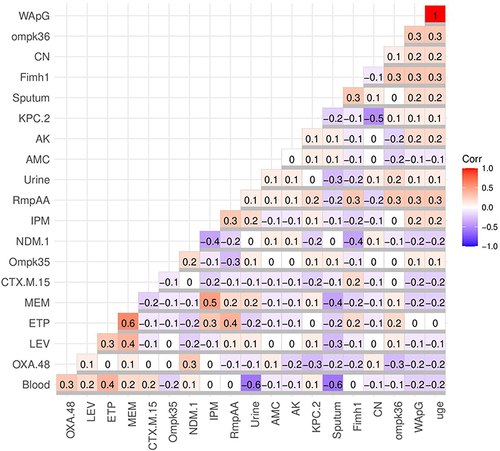Figures & data
Table 1 Nucleotide Sequences and Amplicon Size of Oligonucleotides Primers
Figure 1 Number of resistant K. pneumoniae [with blue color] and CRKP [with red color] isolates to each antimicrobial.
![Figure 1 Number of resistant K. pneumoniae [with blue color] and CRKP [with red color] isolates to each antimicrobial.](/cms/asset/32646b56-ec3b-4ec3-95fa-809c0c4326bf/didr_a_387742_f0001_c.jpg)
Figure 2 Hierarchical clustering of CRKP isolates, according to the generated antimicrobial resistance patterns, virulence, and resistance genes profiles. Blue and red colors indicate the absence and presence of genes or resistance to antimicrobials, respectively. The code numbers on the right side of the heat map denote the CRKP from urine (U), blood (B), and sputum (S).

Figure 3 Fan dendrogram showing the heterogeneity of CRKP isolated from blood (B), sputum (S), and urine (U) samples.

Figure 4 Correlation coefficient (r) between CRKP sample types and antimicrobial resistance, the existence of both resistance and virulence genes. Blue and red colors specify negative and positive correlations, respectively. The correlation coefficient (R) was indicated by the color key. The darker blue and red colors indicate negative (R = −0.5:-1) and stronger positive (R = 0.5:1) correlations, respectively. The uge, wapG, ompK, fimH, and rmpA are the virulence genes; meanwhile, oxa, ndm, kpc, and ctx are the antimicrobial resistance genes. The tested antimicrobials include those listed in the abbreviations.

